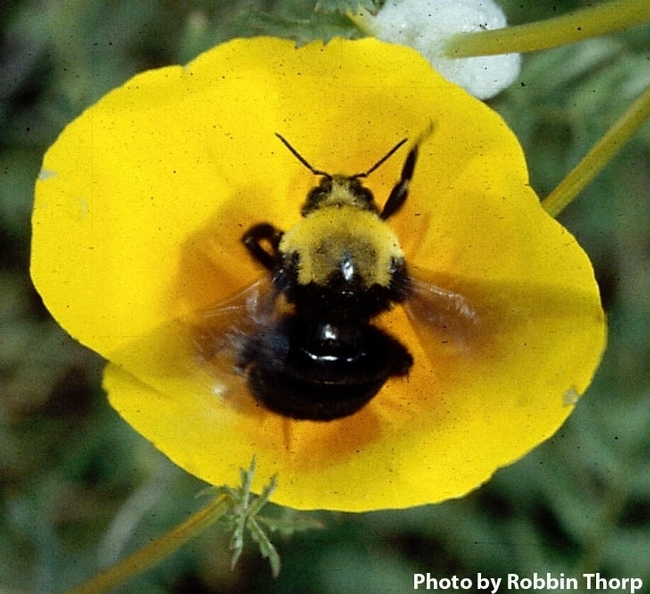
Professor Thorp (1933-2019), a 30-year member of the Department of Entomology and Nematology and a worldwide authority on bees, was a tireless advocate of bumble bee conservation. During his retirement, he co-authored Bumble Bees of North America: An Identification Guide (Princeton University, 2014) and California Bees and Blooms: A Guide for Gardeners and Naturalists (Heyday, 2014).
And every summer from 2002 to 2018, Thorp volunteered his time and expertise to teach at The Bee Course, an annual workshop sponsored by the American Museum of Natural History and held at the Southwestern Research Station, Portal, Ariz.
Thorp also served as the regional co-chair of the Wild Bee Specialist Group of the International Union for Conservation of Nature (IUCN) and sounded the alarm about bumble bee declines, including Franklin's bumble bee, Bombus franklini, found only in its narrow distribution range of southern Oregon and northern California. Thorp last saw it near Mt. Ashland in 2006 and it is is now feared extinct or at the brink of extinction. The bee inhabits--or did--a 13,300-square-mile area confined to five counties--Siskiyou and Trinity counties in California; and Jackson, Douglas and Josephine counties in Oregon.
Enter the California Bumble Bee Atlas (CBBA), a collaboration of the California Department of Fish and Wildlife (CDFW), Sacramento, and the Xerces Society for Invertebrate Conservation, headquartered in Portland, Ore. Launched in March 2022, the Atlas is a "collaborative community science effort to track and conserve the state's native bumble bee species," according to Dylan Winkler, bumble bee scientific aide for the CDFW's Wildlife Diversity Program.
Back in September 2021, the U.S. Fish and Wildlife Service announced that the American bumble bee, "whose populations have plummeted by nearly 90 percent, may warrant Endangered Species Act protection." The announcement kicked off a one-year status assessment of the species. (See news story)
If you're interested in bumble bee conservation, take note. Winkler will lead a "Bumble Bee Walk" from 10 a.m. to noon on Saturday, May 28 in the UC Davis Arboretum and Public Garden. The goal is to teach interested participants how to survey bumble bees. You can pre-register at https://arcg.is/0PDyO4. Organizers plan to cap attendance at 20 people. Details about this Atlas event and several more scheduled in June:
- Saturday, May 28: UC Davis Arboretum, Davis, CA (Yolo County), parking at Putah Creek Lodge Parking Lot, Garrod Drive, Davis, CA 95616. Tour of the native plant gardens and the forest along Putah Creek from 10 a.m. to noon.
- Saturday, June 4: The Gardens at Lake Merritt, 666 Bellevue Avenue, Oakland, CA (Alameda County). Tour of the gardens from 9 a.m. to 11 a.m.
- Sunday, June 5: College of Marin at Kentfield (Marin County), parking at covered Lots 6/7 off College Ave, Kentfield, CA 94904. Details: Meet at bridge over Corte Madera Creek. Tour of the campus native plants from 10 a.m. to noon.
- Saturday, June 18: Soil Born Farms, Rancho Cordova, CA (Sacramento County), parking at Soil Born Farms: American River Ranch, 2140 Chase Drive, Rancho Cordova, CA 95670. As part of National Pollinator Week, the group will tour the gardens from 10 a.m. to noon. Closed-toed shoes required.
Of the 50 species of bumble bees found in North America, an estimated 25 inhabit California. Overall, a quarter is at risk, according to the Atlas website. The decline is attributed to "loss or fragmentation of habitat, pesticide exposure, climate change, overgrazing, competition with honey bees, low genetic diversity, and perhaps most significant of all, the introduction and distribution of pathogens through commercial honey bee and bumble bee colonies used for crop pollination. All of these factors likely interact, increasing pollinator vulnerability. To support bumble bees, it is critical to protect existing habitat while creating and maintaining new habitat."
Winkler says "we will be using butterfly nets to catch bees, then move them to small vials, and chill them in coolers with ice, so we can take ID'able photographs of them before releasing." The full protocol is at https://www.cabumblebeeatlas.org/point-surveys.html
What bumble bees might you see May 28 in the Arboretum? Bombus vosnesenskii, the yellow-faced bumble bee, and B. melanopygus, the black-tailed bumble bee. "There is a record of B. crotchii at the arboretum from last year around the same date, which is rare and would be amazing to see!" Winkler said.
The project is funded by the U.S. Fish and Wildlife Service through the Wildlife and Sport Fish Restoration Fund. Funding is also provided by the Bureau of Land Management and several private foundations. Read more about the project and the list of coordinators here.
Attached Images:
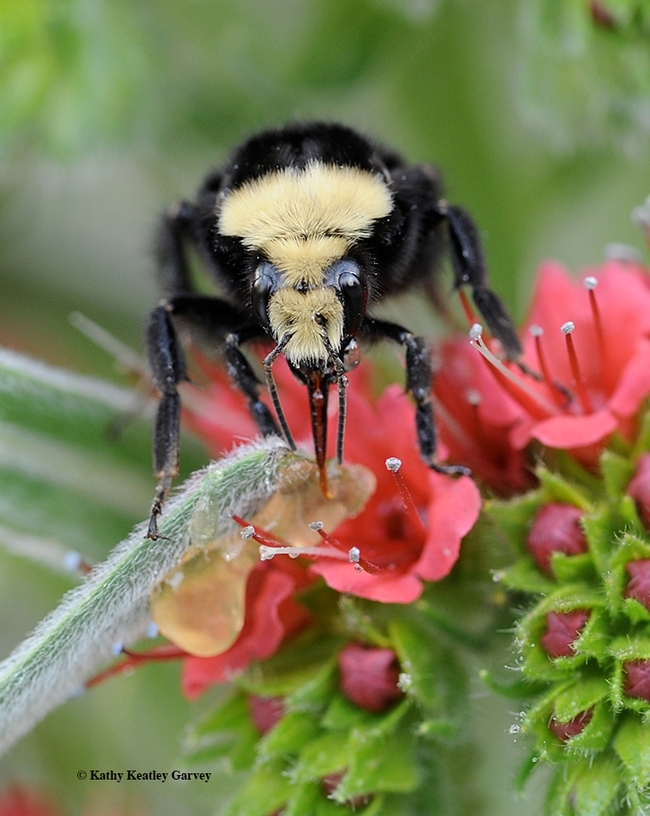
A yellow-faced bumble bee, Bombus vosnesenskii, foraging on a tower of jewels, Echium wildpretii. (Photo by Kathy Keatley Garvey)
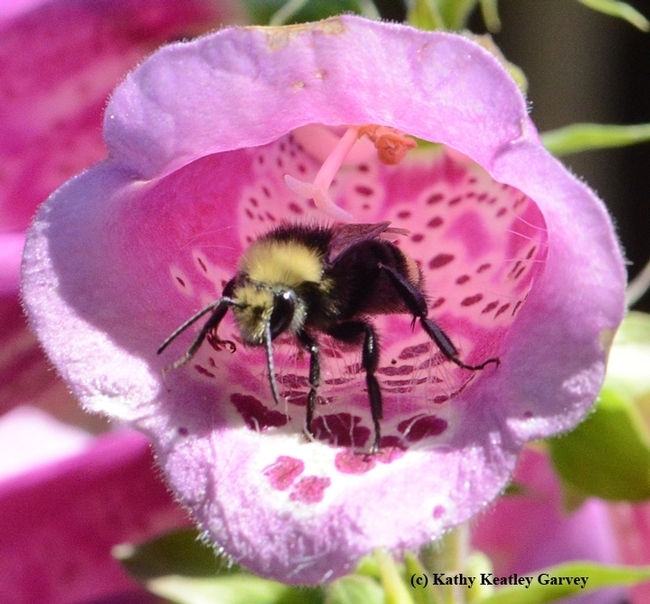
A yellow-faced bumble bee, Bombus vosnesenskii, foraging on foxgloves. (Photo by Kathy Keatley Garvey)
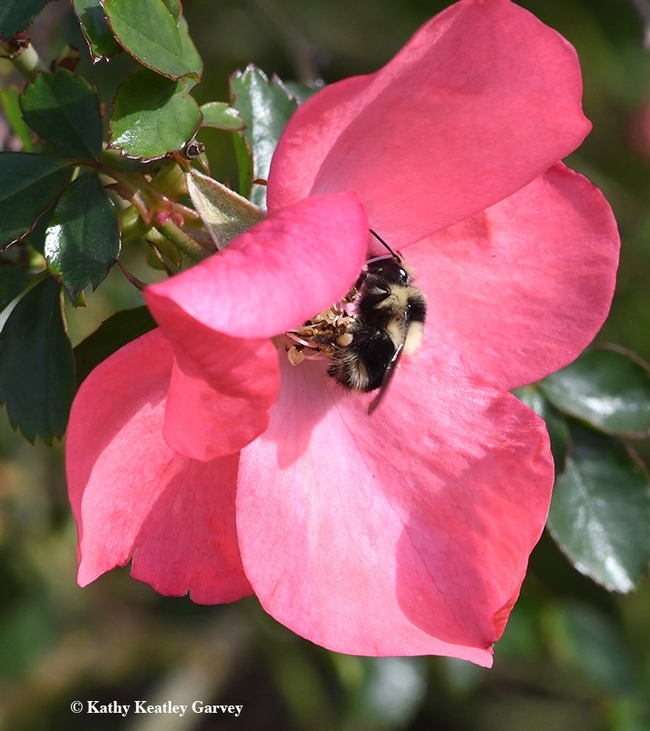
A black-tailed bumble bee, Bombus melanopygus, foraging on a rose. (Photo by Kathy Keatley Garvey)
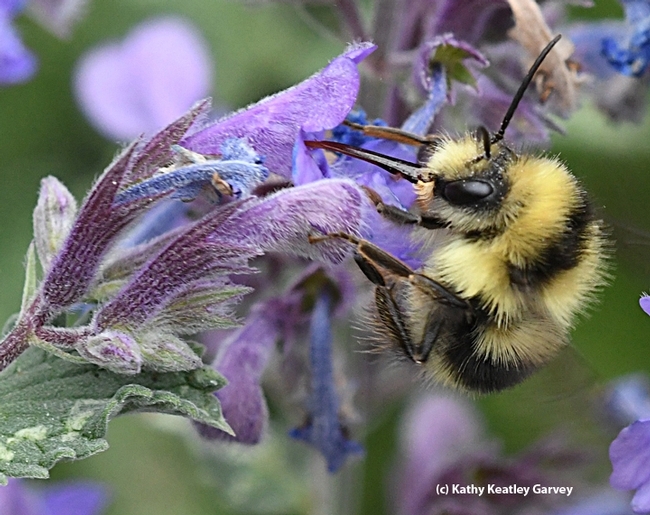
A male black-tailed bumble bee, Bombus melanopygus, foraging on a lavender. (Photo by Kathy Keatley Garvey)
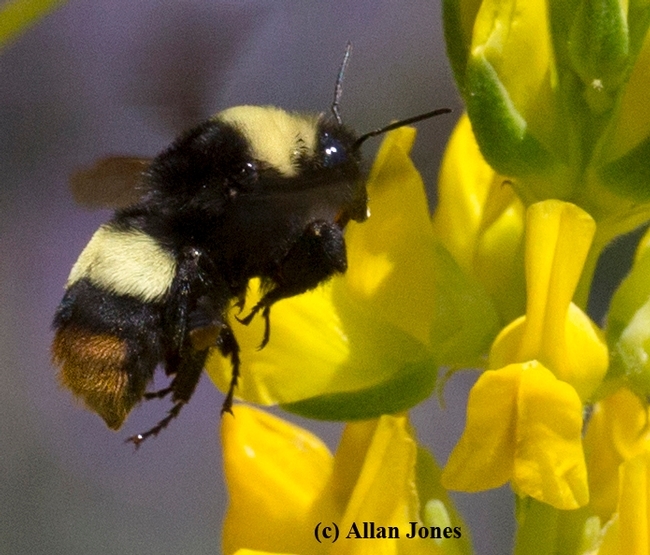
Bombus crotchii foraging in the UC Davis Arboretum and Public Garden. It has been named an endangered species due to the impacts of pesticides, climate change, and human development. (Photo by Allan Jones)